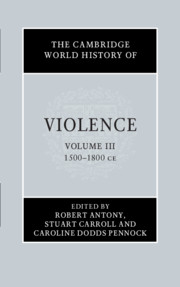Book contents
- The Cambridge World History of Violence
- The Cambridge World History of Violence
- The Cambridge World History of Violence
- Copyright page
- Contents
- Figures
- Maps
- Contributors to Volume iii
- Introduction to Volume iii
- Part I Empire, Race and Ethnicity
- Part II Cultures of War and Violence
- 6 Chinese Ways of Warfare
- 7 The Wars of Invasion in the Caribbean and Mesoamerica, 1492–1547
- 8 The Yogi’s Way of War
- 9 Warfare in Europe
- 10 War, State and the Privatisation of Violence in the Ottoman Empire
- Part III Intimate and Gendered Violence
- Part IV The State, Punishment and Justice
- Part V Popular Protest and Resistance
- Part VI Religious and Sacred Violence
- Part VII Representations and Constructions of Violence
- Index
- References
10 - War, State and the Privatisation of Violence in the Ottoman Empire
from Part II - Cultures of War and Violence
Published online by Cambridge University Press: 13 March 2020
- The Cambridge World History of Violence
- The Cambridge World History of Violence
- The Cambridge World History of Violence
- Copyright page
- Contents
- Figures
- Maps
- Contributors to Volume iii
- Introduction to Volume iii
- Part I Empire, Race and Ethnicity
- Part II Cultures of War and Violence
- 6 Chinese Ways of Warfare
- 7 The Wars of Invasion in the Caribbean and Mesoamerica, 1492–1547
- 8 The Yogi’s Way of War
- 9 Warfare in Europe
- 10 War, State and the Privatisation of Violence in the Ottoman Empire
- Part III Intimate and Gendered Violence
- Part IV The State, Punishment and Justice
- Part V Popular Protest and Resistance
- Part VI Religious and Sacred Violence
- Part VII Representations and Constructions of Violence
- Index
- References
Summary
Military historians have traditionally depicted the Ottoman’s second siege of Habsburg Vienna and the disastrous, ‘Great Turkish War’ that followed (1683–99) as a decisive victory that saved Europe and triggered Ottoman decline. But what gets lost in this historiography is the extent to which the war profoundly altered the confessional and ethnic make-up of the Ottoman army. The recurring defection of Ottoman Orthodox Christian warrior populations like the Serbs to rival armies, followed by Muslim retribution against them, constituted a sea-change in the nature of Ottoman imperial sovereignty and social relations on the ground. Not only would Istanbul henceforth bar Christian warriors from serving in the army; it was forced to outsource imperial governance and defence to pastoral Muslim warrior populations like Albanians on unprecedented levels. The Ottoman state, however, lacked both the resources and the will to pay and offer them sufficient access to status and power, which meant that these new agents of empire were difficult to control. This chapter sketches the nature and repertoire of violence and crime stemming from Istanbul’s massive privatisation of military and policing powers and its deleterious impact on inter-confessional and inter-ethnic relations in Ottoman society.
Keywords
- Type
- Chapter
- Information
- The Cambridge World History of Violence , pp. 194 - 216Publisher: Cambridge University PressPrint publication year: 2020

